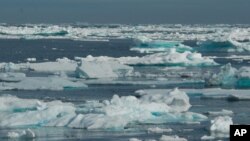A new U.S. space agency study warns the Earth this century could see rapid and catastrophic climate changes if man-made global warming levels are allowed to reach an internationally-recognized so-called “safe limit” of two degrees Celsius.
The NASA researchers examined prehistoric climate conditions during past interglacial periods - the time between ice ages - and compared them with the interglacial period the Earth is currently experiencing. The last interglacial period ended around 115,000 years ago when temperatures were less than one degree Celsius warmer than today, and sea levels were six meters higher.
The scientists say looking at how the prehistoric climate responded to natural changes gives them more insight into determining a dangerous level of man-made global warming for today’s world.
NASA study leader James Hansen says the findings show that Earth’s climate is more sensitive than even recent estimates suggest. He described the notion of limiting man-made global warming to an increase of two degrees Celsius above pre-industrial levels as “a prescription for disaster.”
Recent studies, including those by NASA, indicate the average global surface temperature since 1880 has gone up 0.8 degrees Celsius and is on course to continue rising by 0.1 degrees every decade.
NASA researchers say global warming of two degrees Celsius would more closely match conditions of an interglacial period that occurred some five million years ago when seas were about 25 meters higher than today.
For decades, a two-degree Celsius rise above pre-industrial age levels in average global surface temperatures was considered a safe margin. Many scientists now advocate a threshold of one degree or less and say more has to be done to decrease global warming caused by human activity, such as burning fossil fuels.
Developing and wealthy nations, however, remain deeply divided over how to reduce man-made emissions of climate-changing greenhouse gases, especially carbon dioxide.
An interglacial geologic period, such as the one Earth is now having, occurs when the North and South Poles are frozen, but glaciers do not dominate the rest of the planet. Scientists call the current interglacial period the Holocene epoch. The previous interglacial period is known as the Eemian epoch.
NASA: Earth's Prehistoric Record Warns of Nearing Rapid Climate Change













